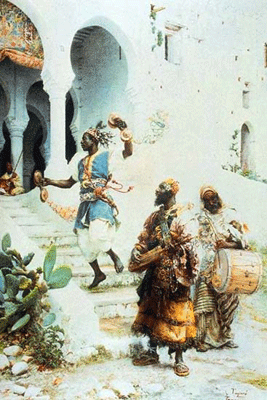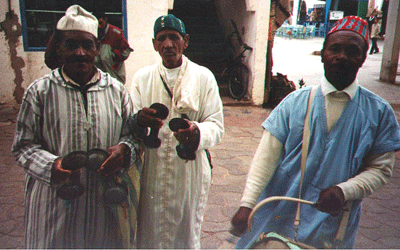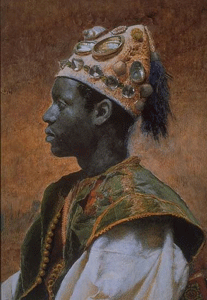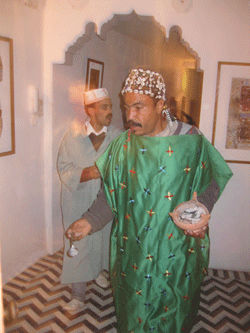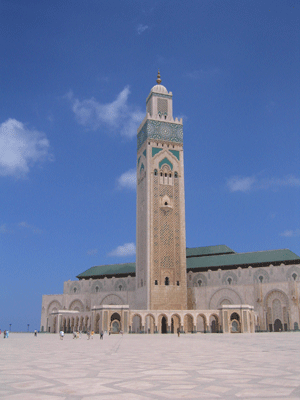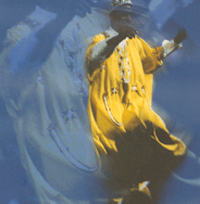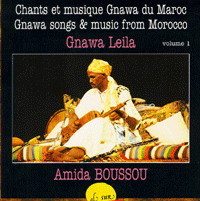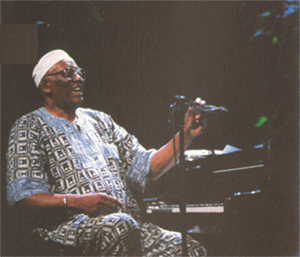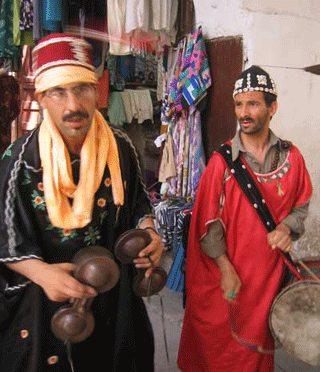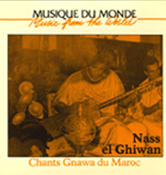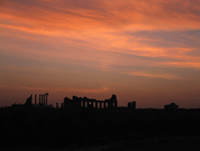Dr. Chouki El Hamel received his doctorate from the University of Paris-Sorbonne in January 1993. His training in France at the Centre de Recherches Africaines was in precolonial African History. His interest has focused on the spread and the growth of Islamic culture and the evolution of Islamic institutions in Africa. His research is evidenced in his published articles and a book concerning intellectual life in precolonial Islamic West Africa. He taught courses in African History at North Carolina State University in Raleigh and at Duke University from 1994 to 2001. In 2001-2002 he was a scholar in residence at the Schomburg Center for Research in Black Culture in New York City and in 2002 he joined the History Department at Arizona State University. He is currently finishing his book, "Black Morocco: A History of Slavery, Race, and Islam" He contributed this essay to Afropop Worldwide for the program African Slaves in Islamic Lands.
Westerners who have visited Morocco have likely encountered Gnawa musicians. In the coastal Atlantic town of Essaouira, where an annual festival of Gnawa music takes place, and in Marrakesh, at its spectacular central square called Jamaa el-Fna. The colorful gowns and caps of Gnawa musicians, covered with cowry shells, coupled with the distinct sound of their instruments - metallic castanets, heavy drums and a three-stringed bass lute (guembri) – provide both visual and audio confirmation of the Gnawa presence.
Some of the best known genres of music to all Moroccans come from the classical Andalusian legacy, and reflect Morocco's historic relationship with Spain. Andalusian music is recognized as a national music and is repeatedly featured on national audio-visual media. By contrast, the Sephardic music and folksongs from the Jewish communities in Morocco are unfortunately vanishing because Morocco lost its Jewish population to help create the state of Israel. Another important but often neglected genre of music is that of the Gnawa, who came from West Africa to Morocco by way of migration, both voluntary and forced. Although the Gnawa are now fully integrated in Moroccan society, the Gnawa still remain a cultural and a social distinctiveness.
The term Gnawa has three important meanings. First, it refers to black people who were enslaved in West Africa. It is commonly believed that Gnawa of Morocco were originally black slaves and who over time had become free under various historical circumstances. Historians believe that the Gnawa population originated from black West Africa - from Senegal to Chad and from Mali in the north to Nigeria in the south. Many of these enslaved people are thought to come from Old Ghana (a kingdom north of Mali) in the 11th through the 13th century. These enslaved groups were called “Gnawa.” There is also some historical evidence that a large enslaved population came from the great market of Djenne in Mali, and that Gnawi is a slight deformation of Jennawi. The term Gnawa is thus a color designation. It historically means “the black people.”
Second, it defines both a religious/spiritual order of a traditionally Black Muslim group. The Gnawa are traditionally a mystic order which marks their exclusiveness within Islam and the religious and spiritual components of Gnawa practice incorporates references to their origin and their enslavement.
Third, it denotes the style of music associated with this order. The ancestral memory (turath) of the displaced and enslaved people that were brought to Morocco is preserved mainly in their songs and dances.
Not all blacks in Morocco were slaves that originated from black West Africa. Some blacks were actually native to southern Morocco. Some sources suggest that groups of black people were indigenous of the Draa valley. They were sedentary agriculturists. With the advance of the Romans into the Moroccan interior in the 3rd century B.C.E., the Berbers, who inhabited the coastal areas of the Maghreb of North Africa, may have been forced to move towards the south and competed with the blacks inhabitants in the oases of the Draa, entering into an interdependent or clientele relationship with the Blacks, with the Berbers assuming the patron role.
Etymologically speaking, the meaning of Gnawa likely derives from the Berber word aguinaw, which is connected with skin color. It means “black man” in contrast with the white Berber. This word could be itself the origin of the name Guinea because akal n-iguinamen in Berber means the “land of the black men” just like the Arabic term bilad as-sudan, which means, “land of the black people.” The term was also adopted by the Portuguese and appeared mainly as “Guinea” on European maps dating from the 14th century.
Arabic sources indicate that there was a steady flow of human trafficking across the Saharan desert from the 10th to the 19th centuries. Since the Almoravid dynasty in the 11th century, enslavement, conscription and trade brought people from West Africa (mainly from the area of present-day Mali, Burkina Fasso and Senegal) to the Maghreb (Morocco, Algeria and Tunisia). These enslaved groups were usually called `abid or sudan, both Arabic words, or else haratin or gnawa, Berber words. We can thus name among the ancestors of the black Moroccans of today the Soninke, the Bambara, the Mossi, the Fulani, and the Hausa. Archival sources indicate the use of blacks in the armies of the Makhzen, the central authority of Morocco, and in many cases, entire garrisons consisted solely of black soldiers. Many dynasties relied on black soldiers to maintain their power.
The first ruling dynasty in Morocco to use a large number of black slaves in the army during the Islamic era was the Almoravids (al-Murabitun). During the Almoravids, the ruler Yusuf Ibn Tashfin “bought a body of black slaves and sent them to al-Andalus.” With the additional troops provided through the slave trade, Almoravids defeated Alfonso VI of Castile in 1086 A.D. at the crucial battle of Zallaqa (near Badajoz). Arabic sources indicate that 4000 black soldiers participated in this famous battle. During the succeeding Almohad dynasty, the rulers had a private garrison of black soldiers, who also served as royal guards and during the rule of Muhammad an-Nasir, around 1200 A.D., their numbers reached 30,000. During this dynasty, the recruitment of enslaved blacks in the government became institutionalized, known as `Abid al-Makhzen, meaning “servants to the government.”
A third dynasty that used a large army of blacks was the Sa‘dis, who under the rule of Mawlay al-Mansur, invaded the Songhay Empire (in present day Mali) in 1591 A.D., which allowed them direct access to acquiring more black slaves for military purposes. In the late 17th century, Mawlay Isma`il gave orders to enslave all blacks including free black people to create his own army. Of course an act completely against the Islamic law, but he did it anyway.
In addition to the conscription of the blacks in the army, enslaved Black West Africans were assigned numerous occupations, including tasks in the home, farm, mines, oases, and ports. In many towns, slaves were primarily women who performed domestic labor or were concubines to the affluent class, while rural slaves were mainly male and worked in farming. Gradually, enslaved black people were freed either by manumission, by running away, or because their masters were forced to grant them freedom under different circumstances. After many generations, these freed black slaves eventually formed their own families and communities, such as those of the Gnawa mystic order.
Elements of pre-Islamic West African animism such as the belief in the spirit world are fundamental to the Gnawa order. For the Gnawa, the spirit world is inhabited by ancestral spirits who, among other spiritual creatures, can be used for either good or evil purposes. Ancestors are believed to act as intermediaries between the living and the supreme god, and the Gnawa communicate with their ancestors through prayer and sacrifice. The spirit world is also invoked through special ceremonies, constituted by drumming, clapping, the sound of the castanets, and dances, all designed to enlist the aid of ancestral saints to protect human beings from evil spirits and other predicaments, such as helping persons recover from an illness or a misfortune. These rites often involve spectacular trances through which contact with and appeal to ancestral spirits may be gained.
Even while adopting Islam, Gnawa did not totally abandon their animist traditions but rather continued to observe ritual possession. They combined Islamic tradition with pre-Islamic African traditions, whether local or sub-Saharan West African. After their conversion to Islam, while probably still in their country of origin, the Gnawa adopted Bilal as their ancestor and saint patron. Bilal was the first black person to convert to Islam and to become a companion of the Prophet Muhammad. Claiming Bilal as a patrilineal figure was not only to emphasize the nobility of belonging to Bilal but also an attempt to legitimize their identity in Islamic terms.
Historically, as a racial minority, the Gnawa suffered much discrimination and injustice at the hands of the Arab-Berber majority within the regions that the Gnawa inhabit. Conscious of their difference and their blackness, they chose Bilal a black man as agnate. Bilal was a special man. Originally from Ethiopia, he was born into slavery. He converted to Islam while still in captivity and was tortured for his conversion by his master Umayya b. Khalaf. When Abu Bakr as-Siddiq, a very close friend to the Prophet Muhammad, heard about the valor of Bilal, he bought him and set him free in the name of Islam. Bilal became the personal servant/assistant of the Prophet. He was also the first muezzin—meaning “caller to prayer”—of the newly established Islamic community in Medina. This special relationship with the Prophet brought Bilal a specialBaraka (a divine blessing). The Gnawa have constructed their Islamic identity by emphasizing a privileged status among Muslims - they converted to Islam even before Quraysh, the tribe to whom Muhammad belonged. Hence, it is not surprising to find the name of Bilal in many Gnawa songs. Additionally, to honor their spiritual and emotional link with Bilal and Islam, the Gnawa built a unique shrine in Essaouira dedicated to Bilal: the Zawiya Sidna Bilal, a place to celebrate their culture. Bilal is the symbol of the dialectic between Diaspora and homeland.
The Gnawa are a diasporic culture and one finds artistic and spiritual parallels between the Gnawa order and other spiritual black groups in Africa such as the bori in Nigeria and the stambouli in Tunisia, thesambani in Libya, the bilali in Algeria, and also outside Africa as in the case of the vodoun religion practiced in Caribbean countries (vodoun is a mix of Roman Catholic ritual elements and traditional rituals from Dahomey). The similarities in the artistic, spiritual and scriptural (e.g. related to Abrahamic written traditions) representations seem to reflect a shared experience of many African diasporic groups. The belief in possession and trance is crucial to Gnawa religious life. Music has served a patterned function in this belief and it is intrinsically linked to the Gnawa religious rituals and to their specific historic and cultural memories. It is their specific historic and cultural memories celebrated and invoked in songs, dances and musical chants that the Gnawa claim to provide access to the spiritual realm.
The Gnawa have influenced other Berber/Arab mystic orders or brotherhoods, as in the case of the Issawiya (16th century) and Hamdushiya (17th century). These brotherhoods added new elements to the usual sufi devotional rituals, such as trances and contacts with spirits, most likely influenced by contact with the Gnawa order. But these Zawaya and other sufi Berber or Arabic orders have been far more socially accepted within the regions where they are found than that of the Gnawa. The Gnawa, as a spiritual order within Moroccan Islamic society, was marginalized and is still marginal. Through their musical ceremonies and trances, they claim to cure insanity and free people from malign influences. They believe that God is too powerful for bi-lateral communication and direct manifestation and thus God can only be reached through spiritual manifestations in our world. Hence, the Gnawa are generally not considered a mystic order proper because they do not seek the conventional personal union with the divine but rather contact with the spirit world which acts as an intermediary through which contact with the divine may be accomplished.
The Gnawa have found legitimacy for their cultural distinctiveness within the regions and societies they inhabit even given their unusual and often marginalized religious rites, ceremonies, and musical practices. The images conveyed in their songs construct a coherent representation of displacement, dispossession, deprivation, misery and nostalgia for a land and a former life kept alive through their unique musical and ceremonial practices. The historical experience of the Gnawa sketched in this essay is very similar to those found in all forced diasporas. Through their ceremonies, their songs and gatherings, these people made restitution not of an "imagined community" but a real one to reconcile a fragmented past. The Gnawa provide a fascinating story of how they re/constructed their identity against a broken cultural continuity.
The Gnawa have, over many generations, productively negotiated their forced presence in Morocco to create acceptance and group solidarity. Unlike the conventional question in Black America, "Who are we?," the Gnawa ask, "Who have we become?” Similar to the model of “creolization” – the integration of freed black slaves into the French cultural landscape of the American state of Louisiana , the Gnawa have created a model of their own creolization and integration into the Moroccan social landscape. This is one of the most crucial and striking differences between blacks in America and blacks in Morocco.
Over the past fifty years in North Africa, Gnawa music, like the blues in America, has spread and attracted practitioners from other ethnic groups, in this case Berber and Arab. Although most present-day Gnawa musicians are metisse and speak Arabic and Berber, some West African religious words and phrases do survive even though their meaning is lost. In Morocco, Gnawa music is found mainly where black people live in a relatively large number; large enough to form a distinctive community like the ones in Marrakech and Essaouira. These two cities are known historically to have had slave markets connected to the trans-Saharan slave trade.
Gnawa people have created a distinct space in Moroccan society. They play a social and spiritual role and in recent decades have become well-known public performers. Public, non-ceremonial performances outside the Gnawa mystic order is a recent development. In order to survive, the Gnawa have turned the mystical aspect of their music into a musical art. In the 1970’s, when the only popular music available was the Middle Eastern type, some Moroccan artists start to look into other Moroccan traditions. Some of the best examples are Nass al-Ghiwan who were inspired by the Gnawa mystic order to create an original Moroccan pop music. One of the members of the band was Abd er-Rahman Paco who was himself a Gnawa master musician from Essaouira. Gnawa music has engendered a popular style of pop music for mere entertainment such as Nass al-Ghiwan and Jil-Jilala. These two bands were the most listened to in Morocco in the 70’s and 80’s. In the 90’s, other groups emerged such as Nass Marrakech who blend traditional music with new songs that connect with contemporary themes and audiences. Yet, for the Gnawa, their music is primarily spiritual and used for healing purposes.
However, curiously, Gnawa music, similar to jazz in America, is not recognized as a national music. The national Moroccan music is the Andalusian music, which developed, in "Muslim" and came to with the expulsion of the Moors in 1502 A.D.. Gnawa music has inspired the development of popular Moroccan music in general and is analogically similar to the African-American spirituals, gospels, and eventually the genre known as “the blues,” also founded by former slaves. Gnawa music provides a perspective through which we may view the history of blacks in . It is a medium to discover and recover the African roots that still live on in Morocco.
Recently, Western musicians interested in African traditional music, have “discovered” the music of the Gnawa. As a result, many collaborations have ensued with famous jazz artists such as Randy Weston. The Gnawa are modernizing their style to make it more secular and with more commercial appeal. With these recent developments and their appeal to tourists, the Moroccan government in 1997established The Gnawa and World Music Festival in Essaouira.
Q&A with Banning Eyre
B.E: What do we know about slavery in Morocco before the Arabs came, even before the Romans came?
Chouki el Hamel: There was always slavery. Berbers were slaving blacks. Blacks were also enslaving other people. But before the coming of the Arabs, black West Africa was not perceived like a huge pool of slaves. It did not have great slave markets. That was a development that came with the Islamization of Africa. So with the Islamization of Africa there was an increase of the trans-Saharan trade. It is the conquest, actually, that stimulated this need for black soldiers. So there was a huge demand for enslaved people from West Africa. And why? It is because, legally, you can slave only people perceived to be “pagan.” And the area that was perceived to be “pagan” was the area of the Sudan and beyond that.
The race question came during the Crusades where Europe emerged as a strong power, and basically, the enslaved people who came from areas in Europe were diminishing. So the Arabs and Berbers dynasties that ruled North Africa turned, of course, south. And then slowly it became color slavery. So that is why I have said that in many dynasties, that ruled Morocco for instance, they relied on black soldiers. And during Mawlay Isma`il, it went even further because he enslaved all blacks, including the free ones, including the Muslims. That is an act that is actually outright illegal in Islam, but he did it. But the muftis, judges and scholars of Islam in Fez were against that. They went against the voices that had influence on the society, they were sometimes killed. We have evidence that one of them was killed. His name is Gassus. He was a very strong voice against the enslavement black Muslims.
B.E: How, ultimately, did slavery disappear from Morocco?
Chouki el Hamel: I don't know of any text that formerly and officially abolished slavery. Slavery just went away with the coming of the colonization in 1912. Slowly, and gradually, slavery just died. It stopped existing because it was no longer needed. For instance, I'll give you just one example. In the south of Morocco, until recently under colonialism, the black people, especially Haratin in the southern oases, in the area of Aqqa or Tata, blacks did not own land. The Berbers owned the land. Some were not slaves, but they worked as sharecroppers. And they were called khammasin. They worked as farmers on the land that belonged to the Berbers, and they got a fifth of the harvest. But they never owned the land. And it is through colonization, when the capitalist system was introduced, and cash was introduced, some of these black people who worked as sharecroppers went to Europe. They were able to have enough cash to buy the land. So it was through colonialism and the general capitalist system that these people who were marginalized, who were not entitled to own land, they suddenly had cash. And cash of course is power. So they bought land, and this has created a social mobility in the south of Morocco.
B.E: When Afropop Worldwide went to Morocco in 2004, we found the very first two CDs by Nass el Ghiwan. They were just bootlegs, but rare stuff?
Chouki el Hamel: Nass el Ghiwan emerged, actually, from very poor neighborhoods. Their songs were what we call engaged, engaged for social causes. They were singing basically for the voiceless people. They represented them, their oppression and their misery and also subjects that were taboos. Some of them actually suffered for that. They went to jail because of that. They really reflect the cultural legacy in a way of the Gnawa. Because of the times, when there were Egyptian songs playing on the radio all the time, and these people came along, and said, we have to look at Moroccan traditions, what is authentic. And they looked into the Gnawa. And some members of Nass al-Ghiwan and Jil-Jilala were actually Gnawa.
B.E: They were widely influential also. I remember interviewing Khaled in Algeria, and him saying that Nass el Ghiwan really inspired him when he was young. To hear this local sound elevated to this level of high popularity. That's an interesting collateral effect that you would not necessarily predict?
Chouki el Hamel: And now, there is a step even further, because we have westerners involved, right? You have a lot of jazz and even popular music artists they come and collaborate with the Gnawa. Randy Weston comes to mind, but he is not the first one. Dizzy Gillespie went to Tunisia, right? So they all look for this, the African roots. Even in the early sixties. They were aware of this Diaspora. I think the artists were onto something. The artists, they are pioneers in making the other Diaspora actually known to the world. By the “other Diaspora,” I am talking about the internal African Diaspora, which is the Diaspora of black Africans in North Africa and the Mediterranean.
B.E: So it was not so much historians and writers who led the way on this. It was musicians?
Chouki el Hamel: If you like, hearing music is more powerful, more influential, than reading books sometimes.
…Just the same, if books are your cup of tea, here’s Chouki el Hamel’s Selected Bibliography:
Abu, Madyan, and Vincent J. Cornell. The way of Abu Madyan : doctrinal and poetic works of Abu Madyan Shuayb ibn al-Husayn al-Ansari (c. 509/1115-16-594/1198), Golden palm series. Cambridge, U.K.: Islamic Texts Society, 1996.
Brunel, Rene. Essai sur la confrérie religieuse des 'Aissaouas au Maroc: Paris: Librairie Orientaliste Paul Geuthner, 1926.
Diène, Doudou. La Chaîne et le lien : une vision de la traite négrière, Mémoire des peuples. Paris: Editions Unesco, 1998.
Diouf, Sylviane. Servants of Allah : African Muslims enslaved in the Americas. New York: New York University Press, 1998.
El Hamel, Chouki, “Blacks and Slavery in Morocco: The Question of the Haratin at the End of the Seventeenth Century,” in Disaporic Africa. A Reader, ed. by Michael Gomez, New York University Press, 2006.
Ennaji, Mohammed. Serving the master : slavery and society in nineteenth-century Morocco. 1st ed. New York: St. Martin's Press, 1999.
Laroui, Abd Allah. The history of the Maghrib : an interpretive essay. Princeton: Princeton University Press, 1977.
Pâques, Viviana. L'Arbre cosmique dans la pensée populaire et dans la vie quotidienne du Nord-Ouest africain, etc, [Université de Paris. Travaux et mémoires de l'Institut d'Ethnologie. no. 70.]: pp. 702. pl. XVII. Paris, 1964.
Pâques, Viviana. La religion des esclaves : recherches sur la confrérie marocaine des Gnawa. Bergamo: Moretti & Vitali, 1991.
Willis, John Ralph, ed. Slaves and Slavery in Muslim Africa. Vol. 1: Islam and the Ideology of Slavery. Totowa, N.J: Frank Cass, 1985.








